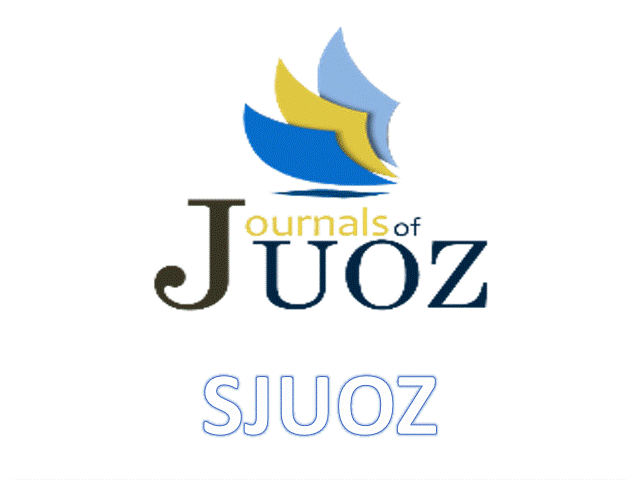Tourch Infections in Mothers with Bod as a Cause of Neonatal Miscarriages and Fetal Malformation in Duhok Province, Kurdistan Region/ Iraq
Keywords:
Women with BOD, TOURCH, Pregnancy outcomeAbstract
This study was performed to demonstrate the effect of TORCH agents on pregnancy outcome of 84 mothers with BOD, the number of single, twice, triple, four and more miscarriages were 102 (55.4%), 50 (27.2%), 27 (14.7%) and 5 (2.7%), respectively. Out of 102 BOH pregnant women with single miscarriage, 43 (42.2%) and 2 (4.9%) were seropositive for anti T. gondii IgG and IgM, respectively, 89 (87.3%) and 17 (16.7) were seropositive for anti CMV IgG and IgM, respectively, 63 (61.8%) and 3 (2.9%) were seropositive for anti Rubella IgG and IgM, respectively and 63(61.8%) and 14(13.7) were seropositive for HSV-2 IgG and IgM, respectively. Regarding women with twice miscarriage, 1 (2.0%), 14 (28.0%) were seropositive for T. gondii anti IgG and IgM, respectively, 16 (8.0%), 43 (86.0%) were seropositive for CMV anti IgG and IgM, 29(58.0%), respectively. The IgG of anti Rubella was recorded in 29 (58.0%) no any case for anti IgM. and 29 (58%) and 3 (6.0%) were positive for HSV-2 anti IgG and IgM, respectively. The number of cases with triple miscarriages, 8 (11.1%) were seropositive for anti T. gondii IgG antibodies, while no any case was found against IgM antibodies. Only, 3 (4.2%), 22 (30.6%) were seropositive for anti CMV IgG and IgM respectively. The seropositivity of anti Rubella, anti HSV-2 IgG and IgM antibodies in group with triple miscarriages were recorded in 12 (16.7%), 10 (13.9%), 0 (0.0%) and 3 (4.2%) respectively. The number of cases with four and more miscarriages, all (100%) were seropositive for CMV anti IgG and IgM, and one (20%) for T. gondii anti IgG and IgM, while 2 (40%) and 4 (80%),were seropositive for anti Rubella and anti HSV-2 IgG, respectively. Also the results indicated that 134 (72.8%) of all examined pregnant women with BOH have history of miscarriages,14 (7.6%) congenital malformation, 13 (7.1%) intrauterine growth retardation,10 (5.4%) premature labor and 13 (7.1%) still birth. with the predominant of anti CMV IgG and IgM antibodies.
Downloads
References
Abdel-Fattah, S.A.; Bhat ,A., Illanes, S.; Bartha, J.L, Carrington, D .(2005). "TORCH test for fetal medicine indications: only CMV is necessary in the United Kingdom". Prenat. Diagn., 25 (11): 1028–1031.
Abdul-Mohymen, N.; Amal, H.; Farouk, K. (2009).Association between TORCH agents and recurrent spontaneous abortion in Baghdad. IRAQI J. MED. SCI., 7 (4):40-46.
AI-Hindi, A.; AI-Helou, T.; AL-Helou, Y.(2010). Seroprevalence of Toxoplasma gondii, Cytomegalovirus, Rubella virus and Chlamydia trachmatis among infertile women attending in vitro fertilization center, Gaza strip, Palestine, J. Egypt Soc. Parasitol., 40(2): 451-8.
Al - Taie, A. (2010). Serological Study For TORCH Infections In Women With High Delivery Risk Factors In Mosul. Tikrit Journal of Pure Science, Vol.15(1): 193 -198.
Denkers, E. Y.and Gazzinelli, R. T.(1998). Regulation and function of T-cell-mediated immunity during T. gondii infection. Clin. Microbiol. Rev., 11: 569–588.
Denoj Sebastian, K. F.; Zuhara , K. ;Sekaran.N. (2008).Influence of TORCH infections in first trimester miscarriage in the Malabar region of Kerala. African Journal of Microbiology Research, (2):056-059.
Frey, R. J.(1999). TORCH Tests. Gale Encyclopedia of Medicine. 1st Edition. Gale Research Group.
Golalipour, M.J; Khodabakhshi, B. and Ghaemi, E .(2009).Possible role of TORCH agents in congenital malformations in Gorgan, northern Islamic Republic of Iran. La Revue de la Mediterranee orientale, Vol.15 (2): 330 - 336 (Abstract).
Gomella, T.L.(1994). Infectious Diseases: TORCH Infections. In Neonatology: Management, Procedures, On-Call Problems, Diseases and Drugs, Norwalk, CT: Appleton & Lange.
Goncalves, M.A.; Matos, C.B.; Spegiorin, L.C.; Oliani, D.C.; Mattos, L.A. (2010). Seropositivity rate for Toxoplasmosis, Rubella, Cytomegalovirus, Hepatitis and HIV among pregnant women receiving care at a public health service, Sao Paulo state, Brazil, Braz. J. Infect. Dis., 14(6):601-605.
Kadir, M.A. ;Ghalib, A.K, Othman, N.F.(2007). The significance of modified Latex agglutination with 2- Mercapto- Ethanol(2ME) test in differentiation between acute and chronic toxoplasmosis.Assiut.Med.J.,31(1):1-6.
Hadi, N. J. (2011).Prevalence of Antibodies of Cytomegalovirus, Rubella Virua and Toxoplasma gondii among aborted women in Thiqar province, Iraq. Tikrit Medical Journal. Vol. 17 (4): 3-9 .
Jasim, M; Hadeel, A; Ali, I. (2011). Performance of Serological Diagnosis of TORCH Agents in Aborted versus non aborted Women of Waset province in Iraq. Tikrit Medical Journal; 17(2):141-147
Lewis, R. A.(2007). Torch screen , Columbia University Pediatric Faculty Practice, NY. Review provided by Veri Med Healthcare Network.
Marzi, M.; Vigano, A.; Tabattoni, D.; Villa, M. L; Salvaggio, A. (1996). Characterization of type 1 and type 2 cytokine profile in physio-logic and pathologic human pregnancy. Clin. Exp. Immunol., 106: 127-133.
Mladina, N.; Mehikic, G.; Pasic,k. (2002).TORCH infections in mothers as a cause of neonatal morbidity. A. Med Arh.54(5-6):273-276.
Mohammed, J, Hadee,l A, Ali, I. (2011). Performance of Serological Dignosis of TORCH Agents in Aborted versus non aborted Women of Waset province in Iraq. Tikrit Medical Journal,
(2):141-147.
Morton, N. E; Chiu, D.; Holland ,C.; Jacob, P. A. and Pettay, D.(1987). Chromosome anomalies as predictors of recurrent risk for spontaneous abortion. Am. J. Med. Genet., 28:353– 360.
Nabi, S.N; Wasey, A.F.; HaiderKhan, A.A.; Hoque, M. M.(2012). Seroprevalene of TORCH Antibody in Pregnant Women in Bangladesh. JAFMC Bangladesh Vol 8(1): 35 - 39.
Newton, E.(1999).Diagnosis of perinatal TORCH infections, Clin. Obstet. Gynecol., 42:59-70.
Rajendra, B. S.; Usha, P.; Kamlakar, R.K.; Khadse, M.S.; QaziSuresh, V. j. (2006). Serological study for TORCH infections in women with bad obstetric history in Nagpur. India , J. Obstet. Gynecol. India, 56(1) :41-43.
Sadik, M.S.; Fatima, H.; Jamil, K.; Patil, C. (2012). Study of TORCH profile in patients with bad obstetric history .India, Biology and Medicine, 4 (2): 95-101.
Shirahata, T.;Muroyo ,N.; Ohta, C.; Goto, H. and Nakane, A.(1992). Correlation between increased susceptibility to primary T.gondii infection and depressed production of gamma interferon in pregnant mice. Microbiol. Immunol., 36: 81-91.
Stern, J. J; Cerrillo, M.; Dorfmann, A. D; Coulam, C. B . and Gutierrez-Najar, A. J. (1996). Frequency of abnormal karyotypes among abortuses from women with and without a history of recurrent spontaneous abortion. Fertil .Steril., 65:250 –3.
Thant KZ.(2006). Active surveillance for congenital rubella syndrome in Yangon, Myanmar. Bulletin of the World Health Organization, 84:1–80.
Thongchai, T.; Ruengpung, S.; Louisirirotchanakul. S.; Puthavathana, P. and Chantapong, W. (1997).Immune Status in Congenital Infections by TORCH Agents in Pregnant Thais. Thailand, Asian pacific Journal of allergy and Immunology, 15 : 93-97.
Vilibic –Cavlek ,T.; Ljubin-Sternak, S.; Ban ,M.; Kolaric, B.; Sviben, M.; Mlinaric-Galinovic, G.(2011). Seroprevalence of TORCH infections in women of childbearing age in Croatia. J. Matern. Fetal Neonatal Med.,Vol, (2):280-3.
Wegmann, T. G.; Lin, H.; Guilbert, L. and Mosmann, T. R.(1993). Bidirectional cytokine interactions in the maternal–fetal relationship: is successful pregnancy a Th2 phenomenon. Immunol. Today, 14:353–356.
Zhang ,Q.Q.; Cheng, J.Z.(2012). Investigation on TORCH infections for pregnant women and neonates in Yan an City, China. Zhongguo Xue Xi Chong Bing Fang Zhi Za Zhi., (4):386,392.
Downloads
Published
How to Cite
Issue
Section
License
Copyright (c) 2015 Adel T. Al-Saeed, Iman Y. Abdulmalek, Haifa G. Ismail

This work is licensed under a Creative Commons Attribution 4.0 International License.
Authors who publish with this journal agree to the following terms:
- Authors retain copyright and grant the journal right of first publication with the work simultaneously licensed under a Creative Commons Attribution License [CC BY-NC-SA 4.0] that allows others to share the work with an acknowledgment of the work's authorship and initial publication in this journal.
- Authors are able to enter into separate, additional contractual arrangements for the non-exclusive distribution of the journal's published version of the work, with an acknowledgment of its initial publication in this journal.
- Authors are permitted and encouraged to post their work online.








